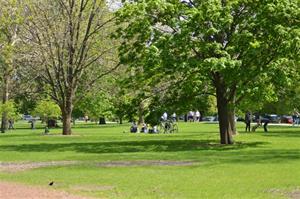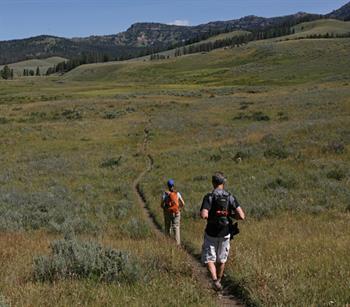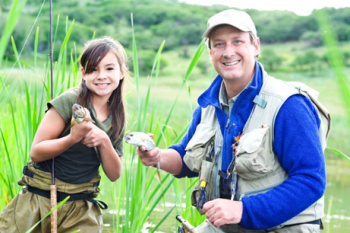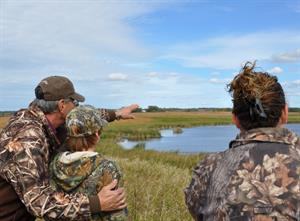 News stories continue to tout the benefits of time spent outdoors.
News stories continue to tout the benefits of time spent outdoors.
Need to improve concentration at work? Reduce anxiety? Sleep better? Help your child manage ADHD? Take a walk outside.
But how many Americans are actually getting outdoors? At face value, the numbers look good.
According to the 2015 Outdoor Recreation Participation Topline Report from the Outdoor Foundation (a non-profit founded by the Outdoor Industry Association to inspire new generations of outdoor enthusiasts), 141.4 million Americans age 6 and older participated in at least one outdoor activity in 2014 outside of organized team sports such as soccer or baseball. Even better, people got outdoors an average of 83 outings during the year. Running, biking, fishing, camping, hiking, bird watching, wildlife viewing (adults), hunting (adults), skateboarding (youth), and surfing (youth) topped the list of outdoor pursuits.
These statistics seem encouraging, but a look behind the numbers is less rosy. For starters, although 141.4 million is a lot of people, it’s only about 48 percent of the U.S. population over the age of 6. In fact, in the nine years the Outdoor Foundation has been tracking these numbers, participation in outdoor recreation has not risen above 50 percent of all Americans. As a result, hundreds of national non-profits dedicated to outdoor sports, including the Izaak Walton League, as well as state agencies in all 50 states have put forth a mammoth effort to introduce programs dedicated to recruiting and retaining participants in outdoor activities.
Are these programs working?
Although the percentages have not improved, overall participant numbers do show a steady increase over the past nine years (with a slight drop in 2014 that the Outdoor Foundation attributes to extreme weather). These numbers also reveal trends to consider if we are to be successful at nurturing the next generation of conservationists through their outdoor pursuits.
Finding an Outdoor Community Close to Home
Traditionally, getting outside meant interacting with the landscape or water in some way, which implies either knowing how to do it yourself or going with someone who does. There’s a major shift in how people define and plan their outdoor experiences today, explains Adam Kramer, executive director of Outdoor Alliance, a coalition of organizations working to conserve public lands and promote human- powered outdoor sports.
“A growing number of people just want places without a ceiling — not far-away aspirational spots but urban green spaces,” says Kramer. “If you look at the hours people spend outside, that’s where most people are. It’s important to recognize that a large part of the population finds merit being outside without going far away.” Which means you can create meaningful outdoor experiences in city parks and other places close to home.
Kramer also emphasizes the social aspect of outdoor recreation. “People are connecting through social media for group fitness activities, bike rides, and hikes. It’s a community experience.” He offers two definitions of “community” — one related to a person’s Zip code and the other to a person’s peer group. The latter is more likely to keep someone engaged but requires a different strategy for recruiting participants.
Kramer points to Web sites such as MeetUp.com (tagline: “Find your people”) as a more effective way to recruit participants than a traditional ad in the local newspaper or posters around town. “I’ve been kayaking since the 1990s,” says Kramer. “It would never have occurred to me to use a Web site like MeetUp.com because I’m already in the kayaking culture. I know where to go. But if you don’t know, the barrier is high. Now any person can find a kayak school or a group that’s within their comfort zone and timeframe.” This trend is not unique to kayaking, he says. People are connecting online for every type of outdoor pursuit.
According to Kramer, most people can be enticed into the outdoors if the activity is social (involving friends and family), accessible, and “not scary.” How a person views each of these criteria may depend on demographics.
Using Demographics To Direct Marketing
 According to the U.S. Census Bureau, of the 318.9 million people in the United States in 2014, approximately 62 percent were white, 17 percent Hispanic, and 13 percent African-American, with the remaining 8 percent comprising other ethnic groups.
According to the U.S. Census Bureau, of the 318.9 million people in the United States in 2014, approximately 62 percent were white, 17 percent Hispanic, and 13 percent African-American, with the remaining 8 percent comprising other ethnic groups.
Based on projections by the Pew Research Center, the U.S. population will expand to approximately 438 million people by 2050 and the demographics will shift to approximately 47 percent white and 29 percent Hispanic (with other numbers remaining relatively the same). It’s a well-publicized trend to which outdoor organizations are paying great heed. The image of an older, white angler helping his grandson reel in a fish or a 40-something white hunter holding up the rack of his trophy whitetail will have less and less relevance when it comes to enticing people outdoors.
Different cultures have different ideas about how they want to spend time outdoors, says Kramer.
Families originating from Latin America, for example, may “spend time picnicking and kicking a soccer ball around, and maybe doing a little fishing,” with multiple generations enjoying time outdoors together. “They may not be running rapids or climbing rocks, but their outdoor time is still super meaningful.” It’s important to keep these differences in mind when looking to recruit new participants.
And it’s a key part of the outreach strategy for the Recreational Boating and Fishing Foundation (RBFF), which is dedicated to increasing participation in recreational boating and fishing and stewardship of aquatic resources. Frank Peterson, the organization’s president and CEO, says his group is paying close attention to the country’s growing Hispanic sector and other ethnic groups. “Half the kids under age 5 in the United States are not Caucasian, so for a sport that’s traditionally white, that’s a change,” says Peterson. “Looking down the road a few years, we need to adapt to a multicultural mindset. But some things cross multicultural lines. Families are still important, and people still need mentors to show them the ropes. We emphasize family in all markets.”
“Fishing crosses all ethnicities,” Peterson continues. “Everyone looks for ways to escape, to have time with their family, and to disconnect from media. Fishing affords all of these things. The key is to get the word out in a way that will reach each segment effectively.”
The Recreational Boating and Fishing Foundation’s “Take Me Fishing” campaign is a case in point. In addition to creating Web sites for the campaign in both English and Spanish, marketing surrounding the campaign has slightly different media strategies, depending on the target group. “We make sure everything is offered via mobile devices,” explains Peterson. “Mobile devices are how people are accessing information, especially Hispanics. Eighty-four percent of Hispanics use a mobile device to go to our Spanish Web site, VamosAPescar.org, versus 50 percent [of the people] who go to TakeMeFishing.org.” RBFF’s outreach strategies differ in other ways, too. The organization reaches both groups through social media but uses radio to reach the Hispanic audience and TV and direct mail to reach a general audience.
Fishing for Outdoor Opportunities
 As most Ikes already know, fishing can be a great way to introduce someone to the outdoors. In fact, it could be the key to increasing participation in all outdoor sports says Rob Southwick, president of Southwick Associates, which conducts participation surveys and analyzes trends for the outdoor industry and fish and wildlife agencies.
As most Ikes already know, fishing can be a great way to introduce someone to the outdoors. In fact, it could be the key to increasing participation in all outdoor sports says Rob Southwick, president of Southwick Associates, which conducts participation surveys and analyzes trends for the outdoor industry and fish and wildlife agencies.
“Fishing is a gateway to other activities,” says Southwick. “Of all the outdoor sports, fishing is the largest among those that expose people to wildlife.” For example, once a person starts fishing, he or she might realize how easy it is to launch a kayak, too. “They see it’s not hard to get outdoors and do more than just fish.”
According to the U.S. Fish and Wildlife Service’s 2011 “National Survey of Fishing, Hunting, and Wildlife-Associated Recreation” (the most recent edition of these five-year reports), 30 million people go fishing at least once per year. A whopping 60 million people fish at least once every five years and still consider themselves to be “anglers,” which leads Southwick to believe that most anglers don’t go fishing to catch fish. “That’s icing on the cake,” he says. “People go fishing because it’s fun, it’s social, and it’s outdoors. But church picnics are too.” What’s different about fishing? According to Southwick, people like fishing because they can interact with the fish. It’s also a test of skill. It’s exciting to hook one. And some people, especially kids, like the idea of bringing home something to eat.
To turn a novice into an angler, Frank Peterson offers a three-step process that can be applied to any outdoor activity and any demographic group:
1. Make the person aware of the activity.
2. Invite the person to try the activity.
3. Engage the person more times in the activity.
It’s a simple formula that offers the foundation of an outreach strategy.
The Female Factor
 When it comes to recruiting people to traditional outdoor activities such as hunting, fishing, and shooting sports, another factor to consider is the dramatic increase in female participants.
When it comes to recruiting people to traditional outdoor activities such as hunting, fishing, and shooting sports, another factor to consider is the dramatic increase in female participants.
This change in demographics is good news, considering half the population of the United States is female. “In 2007, about 20 percent of all anglers were female,” says Peterson. “Now, about 34 percent of all anglers in the U.S. are female. Women like [fishing] in part because it’s the type of thing you can do regardless of age, and it gets you outside where you can appreciate the landscape.”
However, an increase in the number of female anglers does not translate into a dramatic increase in days spent fishing. “Women don’t typically fish as frequently and [are] not as likely to travel as men,” says Southwick. “There’s no simple way to separate which women are more likely to go fishing. It’s cultural.”
By “cultural,” Southwick does not mean a person’s ethnic back- ground. If she grew up around others who fished or participated in other outdoor activities — if her grandfather told stories about his out- door adventures or her peers are doing it — then she’s more likely get involved. Hunting is a different story. According to Southwick, hunting is becoming more of an “in” thing on television and there are more camo patterns on clothing, which helps spark interest.
The past decade has also seen steady growth in firearms purchases, including increasing numbers of women purchasing guns. According to a 2014 survey of firearms retailers, 74 percent reported an increase in female customers between 2012 and 2013 and none reported a decrease in female customers. In fact, women account for the largest increase(25 percent) in gun ownership over the last five years. However, these women are not necessarily taking their guns outside.
“Most of the increase is among young, urban females who are purchasing a firearm for personal protection,” explains Jim Curcuruto, director of industry research for the National Shooting Sports Foundation (NSSF), which conducted the survey. “The question is how to convert these new gun owners into competitive target shooters, which then might turn them into turkey hunters and deer hunters.”
In fact, more women are target shooting and hunting. NSSF reports that female participation in target shooting increased from 4.3 million to 5.9 million women between 2004 and 2014. The number of women who hunt also increased over this time period — from 2.7 million to 3.3 million — with the upward trend expected to continue.
Curcuruto believes pop culture is helping recruit newcomers to hunting and shooting sports. “When people watch shows like Duck Dynasty and Top Shot, they think ‘that’s something I can do’,” he says. “There’s also returning military and women who have purchased a handgun for protection who want to practice…. Just like there’s a dozen ways to dance, women quickly learn there’s trap, skeet, cowboy action shooting, deer hunting, and so many other options.”
Making the Trends Work for Your Chapter
Statistics show a snapshot in time or a multi- year trend, depending on the numbers. These numbers alone don’t translate into well-attended, effective outdoor programs, but they do offer tips to get there:
- Look for suburban and urban locations for outdoor activities. Interest is likely high but opportunities likely few in large population centers.
- Emphasize the social aspects of the outing. Gear it toward families or peer groups (friends).
- Promote your event through social media and Web sites used to organize group activities.
- Use photos in your promotional materials that reflect the ethnic diversity of your area and your target audience.
- If your chapter has a Web site, make sure it’s adapted to work well on mobile devices, because that’s how your target audience may find you.
- Consider fishing, bird watching, wildlife watching, or a guided nature walk to attract newcomers to the outdoors. These activities do not require participants to have a high degree of skill to be successful.
- To recruit new hunters, offer a target shooting experience first rather than a hunting one. Once the new recruit becomes proficient at hitting targets, it’s a natural progression to go into the woods. (For someone unfamiliar with a firearm or bow, hunting is often intimidating.)
There’s one final tip that is relevant to recruiting and retaining participants in all outdoor activities: fun. Show a person a good time afield, and they’ll be eager to go again.
By the Numbers
What were the most popular outdoor activities in 2014 (outside of organized sports)? Here’s how Americans like to get outdoors.
Youth (6-24)
Based on participation in the activity at least once per year:
- Running: 25.6% of youth (20.7 million participants)
- Bicycling: 21.2% (17.2 million)
- Camping: 18.5% (15.0 million)
- Fishing: 18.0% (14.6 million)
- Hiking: 12.8% (10.4 million)
Based on frequency of participation during one year:
- Running: 87.2 average outings per participant
- Bicycling: 67.2 average outings
- Skateboarding: 52.8 average outings
- Surfing: 23.4 average outings
- Bird Watching: 22.9 average outings
Adults (ages 25+)
Based on participation in the activity at least once per year:
- Running: 15.8% of adults (33.0 million participants)
- Fishing: 15.0% (31.4 million)
- Bicycling: 12.8% (26.8 million)
- Hiking: 12.4% (25.9 million)
- Camping: 12.2% (25.5 million)
Based on frequency of participation during one year:
- Running: 79.5 average outings per participant
- Bicycling: 54.3 average outings
- Bird Watching: 39.1 average outings
- Wildlife Viewing: 28.0 average outings
- Hunting: 23.3 average outings
Source: 2015 Outdoor Recreation Participation Topline Report, Outdoor Foundation (Outdoor Industry Association).